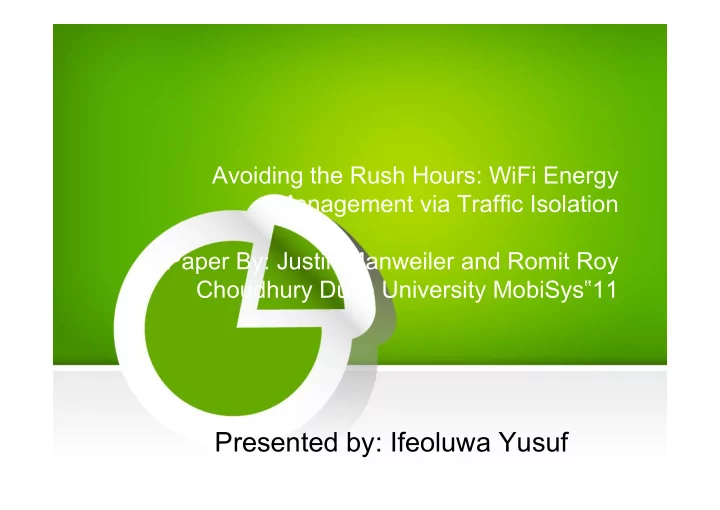

Avoiding the Rush Hours: WiFi Energy Management via Traffic Isolation Paper By: Justin Manweiler and Romit Roy Choudhury Duke University MobiSys‟11 Presented by: Ifeoluwa Yusuf
Introduction • Energy management is a relevant problem. - Always-connected usage model of smartphone - Background application running push- based alert services, location based notifications, and periodic sensor updates • WiFi network communication is a predominate source of energy consumption
Existing WiFi Management • Power Save Mode (PSM) - One of the early protocols that attempts to turn off the device whenever beneficial - Focus on a single device and a single AP ▫Scenario - Client periodically wakes up to listen to advertisements from the AP - Waking up the radio incurs a high energy cost - Clients are made to wake up less frequently permitting multiple packets to queue up at the AP. • NAPman protocol(MobiSys‟10) - Presented at MobiSys‟10 - Focus on multiple devices and a single AP ▫Scenario - Multiple clients wake up after an AP advertisement - Every client must remain awake for a longer duration to receive its packets - AP transmit one packet at a time in a round-robin manner - Key idea: each client believe that it is a associated to a different virtualized AP
The Main contributions are: • Characterize the problem of network contention and its impact on energy consumption. Through measurements we show that the energy-wastage is severe, especially with high device densities in the environment. • Design a lightweight, standard-compatible system running at the AP, that isolates traffic to reduce contention. The system requires no changes to the client, and can quickly adapt to changing traffic conditions and node churn. • Implement and evaluate the system on a testbed of 8 laptops (acting as APs) and 9 Android Nexus One phone clients. Promising performance improvements provide confidence that SleepWell can be an important step towards energy management in WiFi-enabled mobile devices.
Measurements Shows experimental set-up with Nexus One phone connected to power meter via copper tape and DC leads. The phone is entirely powered by the power meter. The computer, connected via USB, records currentand voltage at 5000 hertz.
PSM Energy Profiling WiFi Power Save Terminology • WiFi Power Save Mode (PSM): A suite of polling-based power-optimizations specified by the IEEE 802.11 standard and incorporated in all WiFi implementations. • Constant Awake Mode (CAM): When a PSM-capable WiFi device temporarily disables PSM to minimize latency for interactive traffic. • Beacon Interval: Fixed time duration between two successive AP beacons, typically 100ms (APs continuously transmit these beacons). • Traffic Indication Message (TIM): Virtual “bitmap” embedded in every AP beacon. Indicates which PSM clients should poll to receive queued unicast download packets. • Listen Interval: How often a client chooses to wake up to listen for one AP beacon. Listen intervals are an exact multiple of the beacon interval. • PS-Poll: Client notification to its AP that it is awake and ready to receive a queued packet. Issued immediately after a client recognizes its own ID in a TIM. • More Data Flag: Flag embedded in download unicast data packets that specifies whether more data packets are queued at the AP for a PSM client. Once this flag is set to false, the client may immediately return to sleep.
Power draw over time for Pandora music streaming
Impact of Network Contention on Energy
Sleepwell Design We first describe a basic version of SleepWell under the following assumptions: 1. All APs have saturated traffic. 2. Each AP has one client. 3. All APs are running SleepWell.
Sleep well: Traffic monitoring
Sleep well: Traffic migration Fair share: at least 1 / (n + 1) n : number of other contending APs • Actual share: the time from its beacon to the immediate next • Unsatisfied: actual share < faire share && traffic saturation • If unsatisfied, Find the largest inter- beacon interval (not including its own beacon) If the interval >= 2 * fair share, AP moves to the mid- point of this interval Otherwise, AP migrates its beacon to a time T, such that Tend – T = 1 / (n+1)
Sleep well: Traffic preemption • A client wakes up at the PSM beacon time and downloads packets until AP turns off the MORE_DATA flag • Continuous downloads at different APs include continuous contention • A simple preemptive mechanism - When APi observes that its traffic is likely to “spill” into APj„s, turn off the MORE_DATA flag – APi„s client wakes up at the next PSM beacon - Loose form of TDMA - I.e., avoid “rush hour”
Assumption & Solution • Saturated traffic Introduce and consider needed channel share and available channel share • Single client Buy NAPman‟s idea • No legacy Aps Treat legacy APs identically for the purpose of beacon placement
Evaluation How 2 clients adjust their beacons and preempt traffic to converge on to non- overlapping traffic bursts Energy TDMA
Evaluation: Energy Comparison
Evaluation: Performance gap from the case of zero-contention
Limitations • Not immediately suitable to interactive traffic (VoIP) • True of 802.11 PSM in general • Legacy APs lessen energy savings • Won't preempt for SleepWell traffic • Contention from clients of the same AP • Considered in NAPman [MobiSys 2010]
Related Work • WiFi PSM Sleep Optimization – NAPman, Catnap [MobiSys 10] – μ PM [MobiSys 08] • WiFi Duty Cycling – Wake-on-Wireless [MobiCom 02] / revisited [MobiSys 07] – Context-for-Wireless [MobiSys 07] – Blue-Fi [MobiSys 09], Breadcrumbs [MobiCom 08] – Also, Turducken, Coolspots, Tailender, etc. • Sensor network TDMA – Z-MAC [SenSys 05] – S-MAC [INFOCOM 02]
Conclusion • PSM is a valuable energy-saving optimization • But, PSM designed with a single AP in mind • Multiple APs induce contention, waste energy • Staggered wakeups clients sleep through contention • SleepWell = PSM made efficient for high- density networks
Questions
Recommend
More recommend